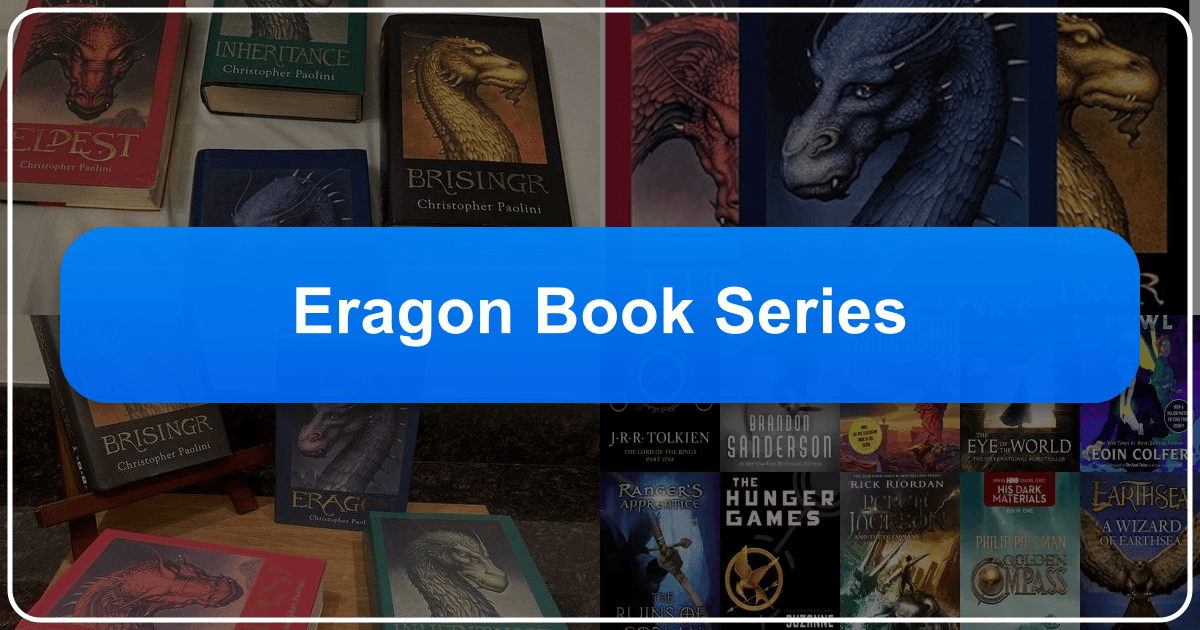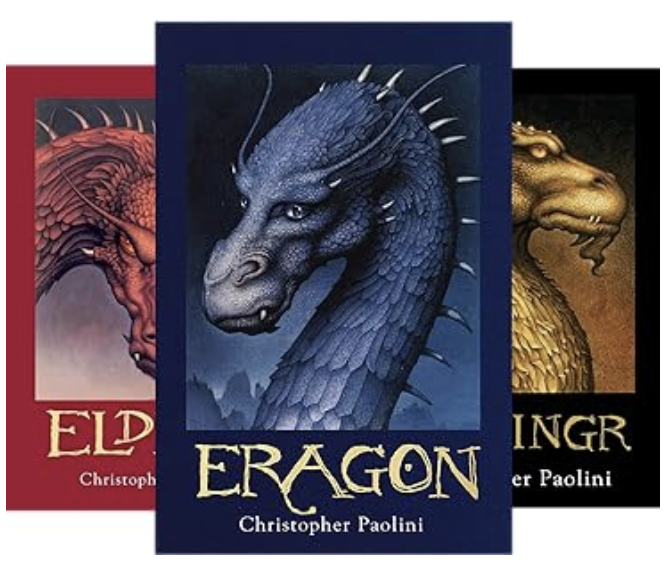The Inheritance Cycle: A Deep Dive into Eragon and Beyond

The Inheritance Cycle, spearheaded by Christopher Paolini’s debut novel Eragon, has captivated fantasy readers worldwide. This sprawling epic, comprised of four main novels (Eragon, Eldest, Brisingr, and Inheritance) along with supplementary works like Murtagh and The Fork, the Witch, and the Worm, presents a rich tapestry of magic, dragons, and a coming-of-age story that resonates with audiences of all ages. This exploration delves into the Inheritance Cycle, examining its literary merit, cultural impact, and the creative forces behind its enduring popularity.
The Books: Fantasy’s Enduring Appeal
The Inheritance Cycle firmly resides within the fantasy genre, specifically young adult fantasy. However, its mature themes and complex characters appeal to a broader audience, encompassing elements often found in high fantasy epics. The series’ success is partially attributed to its accessibility. While filled with intricate world-building and magic systems, Paolini’s writing style remains engaging and relatively straightforward, making it suitable for younger readers while still offering depth for seasoned fantasy enthusiasts.

Each novel in the main series contributes significantly to the overarching narrative:
-
Eragon: This inaugural novel introduces us to Eragon Shadeslayer, a farm boy who discovers a dragon egg, sparking his destiny as a Dragon Rider. The story unfolds as a classic coming-of-age tale filled with adventure, betrayal, and the burgeoning power of magic. It lays the foundation for the complex world of Alagaësia and the conflict between the Dragon Riders and the tyrannical King Galbatorix.
-
Eldest: Eragon’s training intensifies in Eldest, taking him to the mystical land of Ellesméra, home to the elves. Here, he further refines his abilities in magic and swordsmanship, but also faces escalating challenges of political intrigue and betrayal, pushing him to confront his own limitations. This novel significantly expands the lore of Alagaësia, unveiling more about its history and the nature of its magic.
-
Brisingr: This installment marks a shift towards a darker tone. Eragon finds himself burdened by weighty promises and moral dilemmas, battling both internal struggles and external threats. The stakes are raised considerably, culminating in intense battles and difficult choices. The character development intensifies, particularly Eragon’s journey toward moral and ethical maturity.
-
Inheritance: The final book in the core series brings the epic conflict to its climax. Years of training and sacrifice culminate in a desperate struggle against Galbatorix and his forces. The culmination showcases the profound personal growth of Eragon and Saphira, highlighting the heavy costs of war and the enduring power of friendship and loyalty.
The supplementary novels, Murtagh and The Fork, the Witch, and the Worm, offer further exploration of the Inheritance Cycle world, providing additional depth to the characters and events already explored in the main series.
Christopher Paolini: The Author’s Journey
Christopher Paolini, the author of The Inheritance Cycle, is a unique figure in the world of fantasy literature. His extraordinary achievement stems not just from the quality of his writing but also from his remarkably young age when he conceived and wrote Eragon. This unusual journey reflects the creativity, dedication, and ambition of a prodigious talent.
Paolini’s inspirations are diverse and deeply rooted in classical literature and mythology. He draws inspiration from works such as Beowulf, the literary works of J.R.R. Tolkien and E.R. Eddison, and a range of other classic authors. His careful research into Old Norse, German, Anglo-Saxon, and Russian mythology is reflected in the ancient language of the elves, adding an element of authenticity and depth to the world of Alagaësia. His world-building is profoundly influenced by the landscapes of his native Montana, particularly Paradise Valley, bringing a palpable sense of place to the fictional continent he created.

The deliberate inclusion of archetypal fantasy elements—a quest, a journey of self-discovery, themes of revenge, romance, betrayal, and a unique sword—solidifies Eragon’s place within the established canon of high fantasy, yet the unique voice and approach of Paolini sets it apart from many of its predecessors. The detailed character development, especially the evolution of Eragon from an ordinary farm boy into a powerful Dragon Rider, showcases Paolini’s storytelling prowess and emotional maturity. The bond between Eragon and Saphira, his dragon, serves as the emotional core of the narrative, highlighting the themes of friendship, loyalty, and growth.
Reading and Learning from the Inheritance Cycle

The Inheritance Cycle offers more than just an entertaining read; it provides significant educational value and rich life lessons. The series explores complex themes such as:
-
The Nature of Good and Evil: The series does not present a simplistic dichotomy of good versus evil. Characters are complex and morally ambiguous, forcing readers to question their assumptions and consider the motivations behind actions. The struggle between Eragon and Galbatorix is not simply a clash of opposing forces, but rather a nuanced exploration of power, corruption, and the choices that shape one’s identity.
-
The Importance of Friendship and Loyalty: The unwavering bond between Eragon and Saphira is central to the narrative, showcasing the power of true friendship and the importance of unwavering loyalty in the face of adversity. The strength of their relationship serves as a model for readers, highlighting the value of supportive connections and the enduring power of trust.
-
Moral Development and Responsibility: Eragon’s journey throughout The Inheritance Cycle is a testament to personal growth and the development of moral responsibility. He learns from his mistakes, confronts his fears, and ultimately bears the weight of his actions and decisions. The series subtly guides the reader to think critically about personal accountability and the ethical dimensions of choices.
-
Overcoming Challenges and Perseverance: Eragon’s path is fraught with danger and adversity, but he never gives up in the face of challenge. He exhibits courage, perseverance, and an unwavering determination to achieve his goals. The series subtly instills resilience in the reader, conveying the importance of persistence despite hardships and setbacks.
Reading habits, particularly within the fantasy genre, are often connected to escape and immersion. The Inheritance Cycle’s rich world-building and compelling narrative allow readers to escape into Alagaësia, fully engaging with its intricate lore and characters. The series encourages engagement, prompting readers to contemplate its intricate plotlines, reflect on moral quandaries, and absorb the historical and mythological nuances interwoven within the narrative.
Libraries and Archives: Preserving a Legacy
The Inheritance Cycle’s widespread popularity has ensured its presence in numerous libraries and archives worldwide. Public libraries stock multiple copies of the books, catering to the consistent demand from young adult and adult readers. Digital libraries also offer electronic versions, providing broader access. Rare collections and archives may house first editions or early manuscripts, particularly those self-published by Paolini, preserving a tangible record of the series’ origins. These repositories play a vital role in ensuring the enduring legacy of the Inheritance Cycle, making it accessible to current and future generations.
Cultural Impact: A Phenomenon in Fantasy Literature
The Inheritance Cycle has had a profound cultural impact, extending far beyond its literary sphere:
-
Literary Influence: The series has influenced subsequent fantasy works, impacting not only the young adult fantasy genre but also influencing elements of high fantasy. The series’ structure, character archetypes, and world-building have been emulated and expanded upon in various fantasy projects, testament to its influence and impact on storytelling.
-
Adaptations: The series has been adapted into a feature film (Eragon, 2006) and is currently in development as a live-action television series for Disney+. The film adaptation, while receiving mixed reviews, further propelled the series into the mainstream consciousness. The television series adaptation, with Paolini’s involvement, presents an opportunity for a more faithful portrayal of the novels’ complex plots and characters. A video game adaptation also further expanded the series’ reach.
-
Awards and Recognition: The Inheritance Cycle has received various awards and accolades, recognizing the quality of its storytelling and its impact on younger readers. These awards solidify the series’ status within the fantasy literature landscape.
-
Communities: Dedicated online and offline communities have sprung up around The Inheritance Cycle, connecting fans, discussing the series’ intricacies, and sharing their appreciation for Paolini’s work. These communities demonstrate the passionate connection readers have formed with the books, ensuring the series’ enduring legacy. Fans discuss plot theories, explore characters in detail, and create fan art and other creative works. These community efforts help perpetuate the Inheritance Cycle’s cultural resonance and contribute to the series’ longevity.
The Inheritance Cycle’s enduring popularity testifies to its power to capture the imagination, transport readers to extraordinary realms, and inspire reflection on important life lessons. From its initial self-published success to its ongoing adaptations and dedicated fanbase, The Inheritance Cycle is a testament to the creativity of one author and the power of storytelling to transcend age and cultural barriers. Its impact on the fantasy genre and its influence on popular culture continue to shape how fantasy is presented and experienced by readers worldwide.